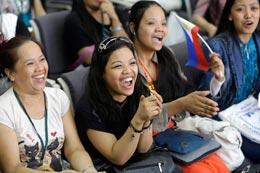Breast cancer hits more Filipino-Canadian women

Filipinos who move to Canada are more prone to having breast cancer at a younger age than women from other parts of East Asia or Caucasians, according to a recent study.
They are also more likely to be diagnosed with a more aggressive form of cancer and are more likely to undergo a mastectomy, according to the paper titled “Breast Cancer Amongst Filipino Migrants: A Review of the Literature and Ten-Year Institutional Analysis.”
Of the 782 patients studied at St. Michael’s Hospital in Toronto, which has a sizeable Filipino patient population, Filipino newcomers to Canada were diagnosed with breast cancer at a younger age (53), compared to other East Asians (55) and Caucasians (58), the study showed, reported GMA news.
“The Canadian Filipino community is a growing community and this new research raises the question of whether our current Canadian guidelines calling for mammograms starting at age 50 are meeting specific cultural needs of different ethnicities when it is known that it takes years for a breast cancer to develop,” said Dr. Jory Simpson, a surgical oncologist in the CIBC Breast Centre of St. Michael’s and one of the three authors of the study.
Moreover, the study also showed that 22.6 percent of Filipinos tested positive for human epidermal growth factor receptor 2, a protein which promotes the growth of cancer cells.
In a statement, Simpson said this was “disproportionately high” compared to those of East Asians (14.4 percent) and Caucasians (15.1 percent).
At least 35 percent of Filipino women with the same sized tumors as other groups underwent mastectomies, higher than Caucasians at 22.5 percent and East Asians at 28.3 percent, the study further said.
“As Canada continues to ethnically diversify this new research only highlights and magnifies the need to take on a more personalized approach to preventing and treating breast cancer,” said Dr. Simpson.
Dr. Simpson said it’s known that women of different ethnic origins have different risks of developing breast cancer. When a women emigrates from an area of low incidence of breast cancer to an area of high incidence, her risk increases, possibly due to new environmental influences such as diet interacting with pre-existing genetics.
Dr. Simpson said he believes his study – albeit a small sample at one hospital – is the first to look at the incidence of breast cancer in Filipino immigrants to Canada. According to Statistics Canada, Filipinos are the third largest non-European ethnic group in the country. Of the 328,000 people of Filipino origin who live in Canada, many are young women.
Of the 782 patients he studied at St. Michael’s, which has a sizeable Filipino patient population, Filipino newcomers to Canada were diagnosed with breast cancer at a younger age (53) compared to other East Asians (55) and Caucasians (58).
They were also found to be diagnosed with a form of more aggressive cancer and have a higher likelihood of undergoing a mastectomy. Thirty-seven per cent had a Grade 3 tumour on a scale of 1-3, compared to less than 30 per cent for other Asians and Caucasians. In addition, 22.6 per cent tested positive for the protein HER2, or human epidermal growth factor receptor 2, which promotes the growth of cancer cells. Dr. Simpson said that was “disproportionately high” compared to East Asians (14.4 per cent) and Caucasians (15.1 per cent).
Filipino women with tumours the same size as their East Asian and Caucasian counterparts underwent more mastectomies in this study, 35 per cent, compared with 22.5 per cent for Caucasian woman and 28.3 per cent for East Asian women.
“Migrant Studies have consistently shown that when a woman moves from a region of low incidence to a region of higher incidence her risk of developing breast cancer increases,” said Simpson and his co-authors, Kaleigh Briggs and Ralph George, in their abstract.
“Many questions remain such as: how do we increase awareness about the benefits of screening mammography in the Filipino community? Should screening start at an earlier age? And finally, how do we ensure that the Filipino women are getting the adequate treatment given the aggressive nature of their breast cancer? Addressing these disparities should be viewed as a priority in breast cancer research,” they added.
The Philippines is a country in Southeast Asia with a population over 92 million; an estimated 12 million people of Filipino origin live overseas.






